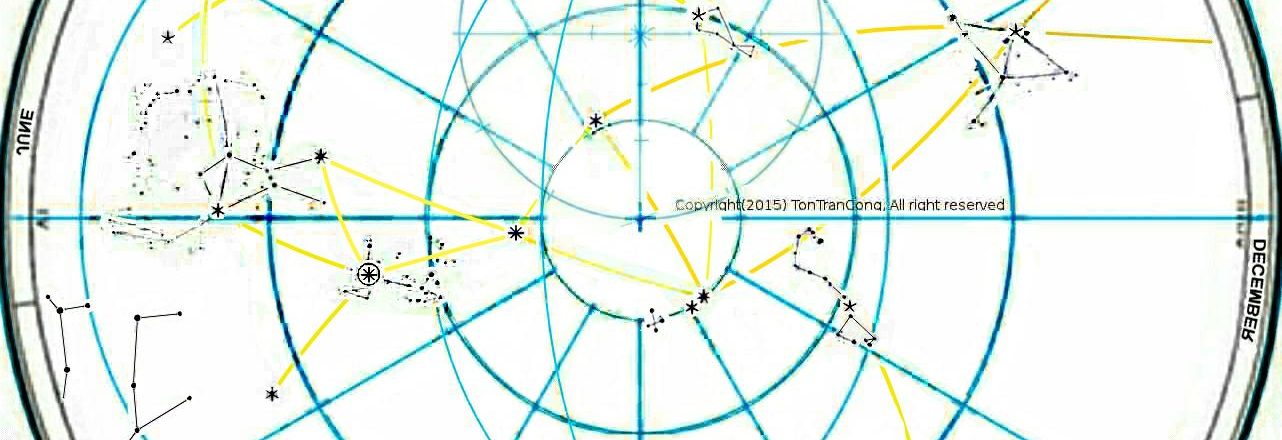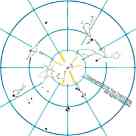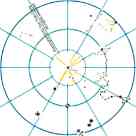The Southern Cross Pointer stars.
by tonytran2015 (Melbourne, Australia).
Click here for a full, up to date ORIGINAL ARTICLE and to help fighting the stealing of readers’ traffic.
(Blog No.111).
by tonytran2015 (Melbourne, Australia).
#find North, #finding North, #navigation, #alpha Centauri, #Agena, #Southern Cross, #pointers, #constellation, #Scorpius,
The Southern Cross Pointer Stars.
Celestial navigators who do not use declination and right ascension begin their navigation by learning the various bright, easily unmistakable constellations in the sky (There are no more than 10 to learn beginning with Orion constellation. and Scorpius constellation.). In the Southern Hemisphere, the Pointers to Southern Cross constellation are next to be learnt as they are very bright and most easy to identify.
The two Pointer stars are two very bright stars (alpha Centauri and Agena) in the Southern Celestial hemisphere. They are very useful as they help identifying nearby navigational stars and consequently finding Southern Celestial pole for navigation.
These two bright stars are circumpolar and are both 30 degrees from to the Southern Celestial pole. They are seen late night in February, all night in May, early night in September.
Inhabitants of Southern hemisphere need only to identify Alpha Centauri (brighter star of the pair), Agena (dimmer star of the pair), and Achernar in the clockwise direction (all at 60° South declination) to find the Southern Celestial pole which is at the center of the circle of 30 degrees in radius through these three stars. Achernar is almost 60 degree from the Pointers (alpha Centauri, Agena) and is opposite them across the Southern Celestial Pole.
Figure: Pointer stars pointing to the Southern Cross on a Polar Skymap for Southern hemisphere.
Extending the line alpha Centauri-Agena (from brighter to dimmer Pointer) by 8 degrees takes us to the Southern Cross Constellation. Then turning clockwise by 50 degrees and extending by an additional 50 degrees takes us to the very bright Canopus star which is nearly 40 degrees from the Southern Celestial pole.
In the opposite direction, extending the line Agena-alpha Centauri (from dimmer Pointer to brighter Pointer) by about 30 degrees takes us to the stinger tail of the large, distinctive Scorpius constellation (this line goes on for another 40 degrees to reach the bright tropical star Altair). From the direction of the line Agena-alpha Centauri (from dimmer to brighter Pointer) turn clockwise by 50 degrees and travel by about 45 degrees from alpha Centauri takes us to the moderately bright star Antares at the heart of the Scorpion.
Figure: Locating an individual star in a crowded area is easily carried out using a folded piece of cardboard: The folding line is aimed at the first known star, one cardboard flap is aligned to contain the second known star. The other flap is then opened to the required angle (marked 1) and the angle to the target star (marked 2) can be read.
2. The Southern Cross.
The Southern Cross is a useful navigational constellation. Its long axis goes through the Southern Celestial pole (which is also nearly on the bisector of the Pointer Stars and is also nearly on the line through Sirius and Canopus) in one direction and goes through the Northern Celestial pole in the opposite direction.
Turning slightly by 20 degrees anticlockwise toward the trailing’ side (Eastern side) from this direction to the Northern Celestial pole and travel by a distance of about 50 degrees from the Southern Cross takes us to the bright star Spica. Turning more anticlockwise towards the Eastern side by an additional 15 degrees from that direction and traveling an additional distance of about 30 degrees takes us next to the very bright star Bootes Arcturus (The direction from Spica to Bootes Arcturus is pointing about 25 degrees to the trailing side, Eastward, from the direction of a great circle arc toward the Northern Celestial pole.).
3. The dates of Pointers to Southern Cross.
Figure 1: The dates of Agena and alpha Centauri from the table of star dates.
The Pointer stars are seen in late night in February, all night in May, and in early night in September.
4. Taking photos of the Pointers.
Figure 1: The Pointers and Southern Cross Constellation are in the lower right quarter of this phpto taken with a Samsung Galaxy Note 2. The original photo has been digitally enhanced.
The Pointers and Southern Cross constellation are adequately bright and their photos can be taken using a smart phone such as a Samsung Galaxy Note 2 with no extra attachment.
The Pointers and 3 corner stars of the vertical Southern Cross are seen on the bottom right of the above two pictures. The dimmer fourth stars of the Southern Cross can be seen in the second photo. Antares is the bright star near the middle of the left border of the second picture. Antares and the front part of the Scorpius constellation are located near the center of the left border of the second picture (The very bright dot near the upper left corner of the picture is a planet.).
Figure 2: Photos of the Pointers and Southern Cross Constellation taken with a Samsung Galaxy Note 2. The original photos have been digitally enhanced.
The two bright Pointers are seen on the bottom right of this picture 2. The two brightest spots on the left half of this picture are two planets traveling on the Ecliptic. Antares is the bright star near the middle of the half left of this picture. Vertically above Antares is the front part of the Scorpius constellation. Vertically below Antares is the bright stinging tail of the Scorpius.
Figures 3: Photo of the Scorpius Constellation taken with a Samsung Galaxy Note 2 at the same time. The original photos have been digitally enhanced.
The Scorpius constellation just mentioned is captured in the center of the third photo. There are four brightest dots on the top of the picture. The far right and far left dots are very bright and are two planets traveling on the ecliptic. The planets on the ecliptic sometimes make confusing the identification of the stars at the front of this constellation.
References.
[1]. tonytran2015, Finding North and time by stars, survivaltricks.wordpress.com, Finding North and time by stars, posted on August 28, 2015
[2]. The Orion constellation., posted December 26, 2016
[3].The Scorpius constellation., posted January 8, 2017
PREVIOUS SURVIVAL blogs
The Orion constellation., posted on December 26, 2016
The Scorpius constellation, posted on January 08, 2017
Identifying moderately bright navigational stars.posted on October 21, 2016
Rice as emergency food, Using GPS in off-grid situations, Slide Sky-Disks with grid masks showing azimuths and altitudes, Slide Sky-Map for displaying tropical stars.…..all.
Click here for my other blogs
SURVIVAL CONTENTS BLOG IMAGE OF SURVIVAL CONTENTS
![]()
MONEY CONTENTS BLOG IMAGE OF MONEY CONTENTS
![]()
SOCIAL ISSUES CONTENTS BLOG IMAGE OF CONT. OF SOCIAL ISSUES
LIVING BLOG LIVING CONTENTS BLOG IMAGE OF LIVING CONTENTS
HOW TO BLOG HOW TO CONTENTS BLOG IMAGE OF HOW TO CONTENTS
Click here go to  Home Page (Navigation-Survival-How To-Money).
Home Page (Navigation-Survival-How To-Money).
ARCHIVAL HOME PAGE CONTENTS HOME PAGE BLOG IMAGE OF CONTENTS HOME PAGE
SUBSCRIPTION: [RSS – Posts], [RSS – Comments]
MENU: [Contents][Blog Image of Contents ][Archives ] [About]















Very neat post.Thanks Again. Want more.
LikeLiked by 1 person
Great, thanks for sharing this blog article.Thanks Again. Awesome.
LikeLiked by 1 person
Muchos Gracias for your post.Thanks Again. Awesome.
LikeLiked by 1 person
For hottest information you have to pay a quick viksit internet and on internet I found this web site as a most excellent website for most recent updates.
LikeLiked by 1 person
Thank you, Sarah.
LikeLike
Nice weblog right here! Also your site a lot up fast! What host are you using? Can I am getting your affiliate link for your host? I want my web site loaded up as fast as yours lol
LikeLike
Thank you for sharing excellent informations. Your site is so cool. I am impressed by the details that you’ve on this site. It reveals how nicely you perceive this subject. Bookmarked this web page, will come back for more articles. You, my friend, ROCK! I found simply the information I already searched all over the place and just could not come across. What a perfect web site.
LikeLike
great post, very informative. I wonder why the other specialists of this sector don’t notice this. You should continue your writing. I’m confident, you’ve a great readers’ base already!
LikeLike
I do not even know how I ended up here, but I thought this post was good. Cheers!
LikeLike
Thank you, I’ve recently been hunting for info about this subject matter for ages and yours is the best I’ve located so far.
LikeLike
Reblogged this on Die Erste Eslarner Zeitung – Aus und über Eslarn, sowie die bayerisch-tschechische Region!.
LikeLike
Thank you, OIKOS-Redaktion, for re-blogging.
LikeLike
Reblogged this on .
LikeLike
Thank you, Brittius, for re-blogging.
LikeLike
You’re welcome.
LikeLiked by 1 person